Let AI do your customer research for you

From my experience, many people who work in sales (as in salespeople and sales engineers) resist doing customer research. Thanks to the availability of Generative AI, it's easier than ever. Before we get into it, let’s have a quick reminder of why it’s key to building relationships and can be instrumental in recovering them.
An object lesson in customer research
It was the end of an excruciating escalation with a customer in the Marketing Technology (MarTech) space. My company had cut off their access to our solution due to compliance concerns, severing their ability to operate a portion of their business without notifying either our account team or the customer. It was great! (sarcasm) The situation ended up involving people at the top of both our organizations. Ultimately their CMO, Matt (not his real name), and I partnered together to resolve the concerns and eventually got them back up and running.
We had just wrapped up the victory call with leaders from both sides virtually patting everyone on the back when Matt texted to ask if I could hang out after everyone else left. I assumed he wanted some private “high fiving”; it had been a tough few weeks.
When it was just the two of us, he started, “Paul, I’m really grateful for all you’ve done to get this resolved so I’d like to share some feedback if you’re open to it,”. It wasn’t the way I expected the conversation to go, but I was down for it. “Absolutely, Matt. I love feedback, especially on me and my team.”
He paused for a moment before continuing. “If I can be honest, I feel like I have to give your team information that’s on the front page of our website. It bothers me. We’ve probably had a dozen sales folks and SEs on our account since I joined and its been the same with all of them. None bothered to understand our business. I know that we’re not a giant account but is this how you treat all your customers?"
OK, that hurt. "It was pretty obvious during our first conversation that you had a feel for what we do. That’s a lot of why I chose to work with you on this. Could you take that back to your team? It really made a difference for us here.”
The exact words may have been a bit different but the sentiment is worth double clicking into - this customer executive felt that our team for years hadn’t bothered to try to understand the fundamentals of their business. It was obvious to them and it had been detrimental to our relationship. It made me wonder - how close were they to forklifting in a competitor when this problem arose? How many opportunities had we lost out on to grow our footprint and bring more value to them because we hadn’t taken the time to educate ourselves? Ugh!
Other than heavily prepping with the team prior to joining my first escalation call with Matt, all I had done was the same 15-ish minutes of research that I do for every customer. It didn’t make me an expert and frankly my grasp on MarTech is tenuous at best, but customers don’t expect us to be. What they do expect from us is to understand the basics of their business. That’s a low bar to get to and one we can achieve incredibly quickly.
Doing customer research used to be a lot harder. Nowadays almost everything you need is just a Google search away. And recently, it's gotten even easier!
Structuring of your initial customer research
This month, we were going to continue the meeting prep series with my approach to knocking out basic customer research in less than 15 minutes. Then I had a epiphany - modern AI tools can do this faster and likely better than we can.
Let’s get started - first, pick your AI tool. I lean towards Microsoft’s Bing Chat because it sources multiple platforms. ChatGPT, which has a ton of buzz at the moment, has a limitation where some of its data sets are a year or more old, especially those related to financials. Either can work.
When educating on a customer, we want to accomplish two goals:
- Understand their business environment enough to grasp their needs
- Understand them enough to have a hypothesis on how we can be impactful
As a result, there are six topic areas to dig into initially:
- Company’s value proposition and primary solutions
- Their competition
- Current financial situation
- Target customers and markets
- Potential challenges and focus areas
- What are they saying publicly
With this information plus a prep session with the team (you are prepping, right?) I am comfortable having initial conversations, asking meaningful questions, and tailoring my responses.
Let's walk through an example
To start, I asked Bing to pick a customer to research for a fictitious conversation I'd be having:

This was left in for kicks and to highlight one of the dangers of AI. Zyntech isn’t a real company. Bing thought I wanted it to make up a tech company. Bing even invented its fictional products and competitors. It wasn’t until we got to financials that it became apparent Zyntech was made up. So let’s realign a bit…

OK, this is a real company. Though I’ve never had the opportunity to work with NVIDIA, I have owned a number of their products so this should be fun. I am a gamer after all…
Let’s start by looking into their value and solutions:
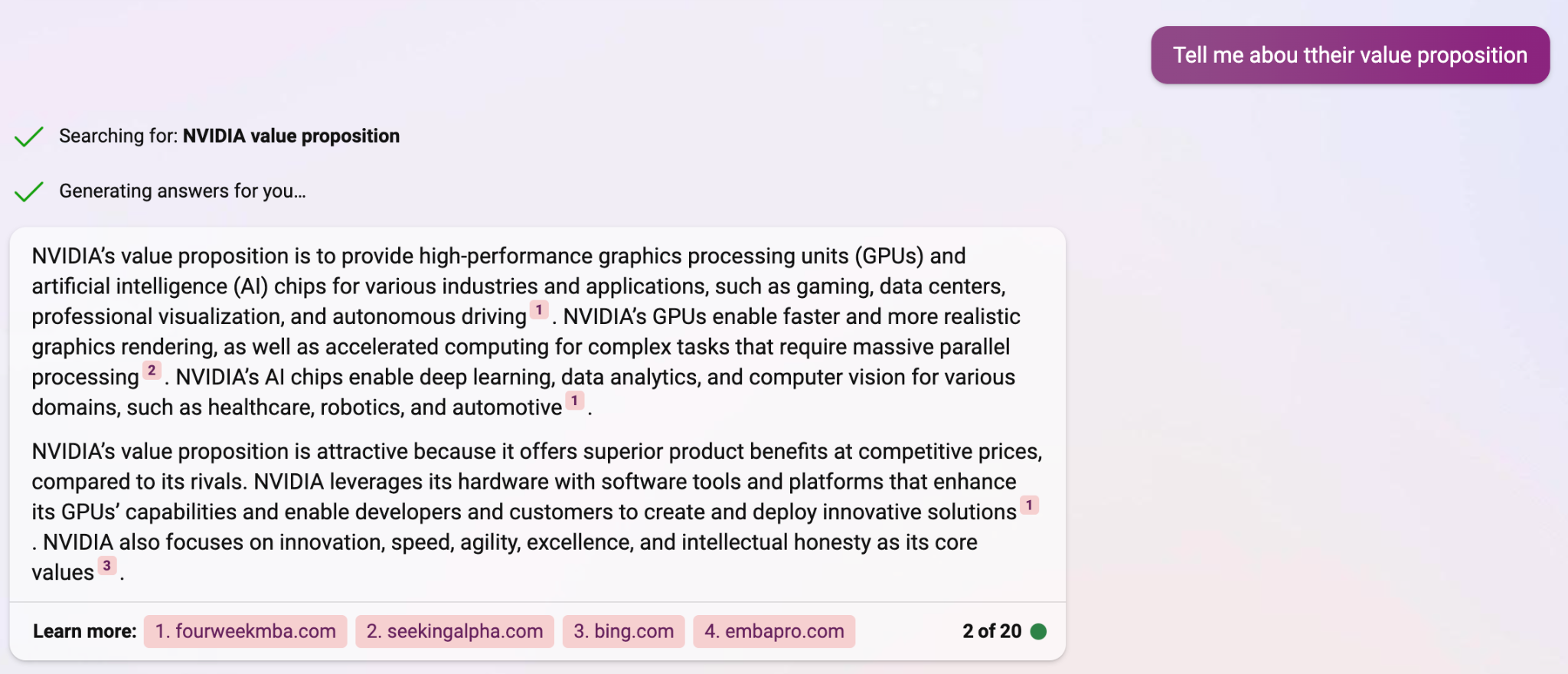
Perfect, covered both aspects in one question. The AI was also smart enough to move past my typo. Now let’s think about the competition:
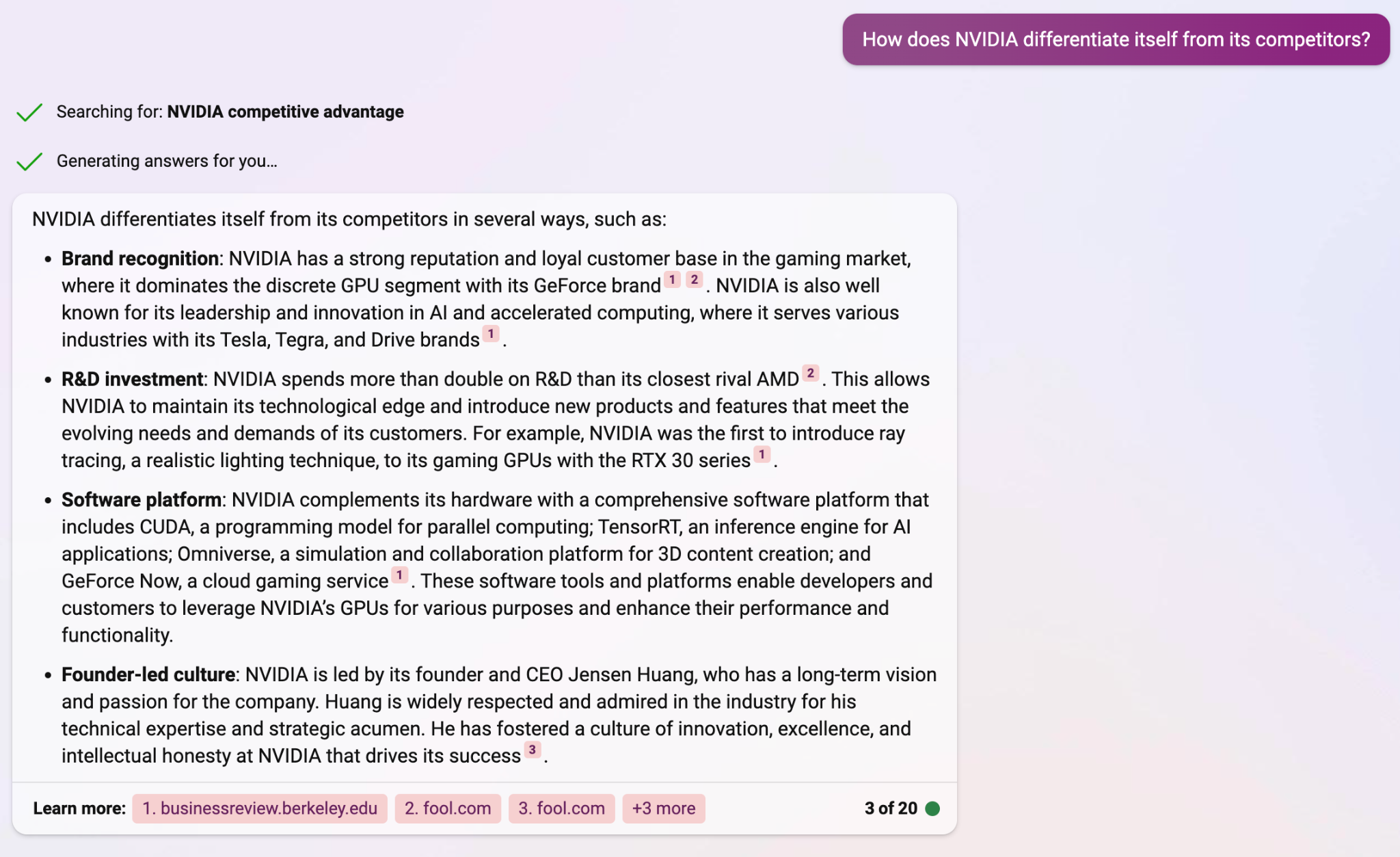
OK, I was already tracking AMD as a competitor. Who else is a threat:
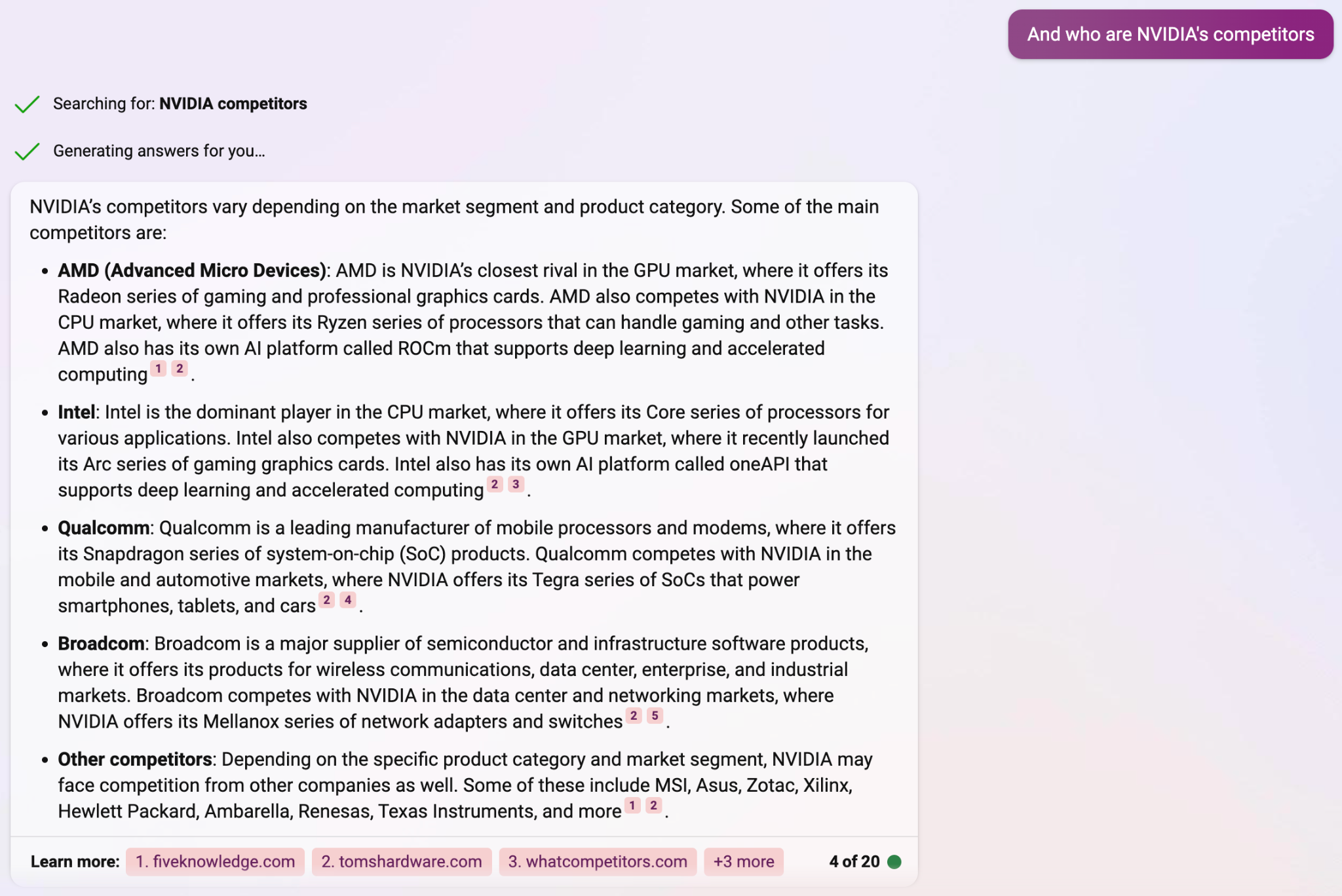
Got it. If this was a real opportunity, I’d be digging into our CRM to see what type of solutions these competitors were using from us or had looked at. Now onward to financials:
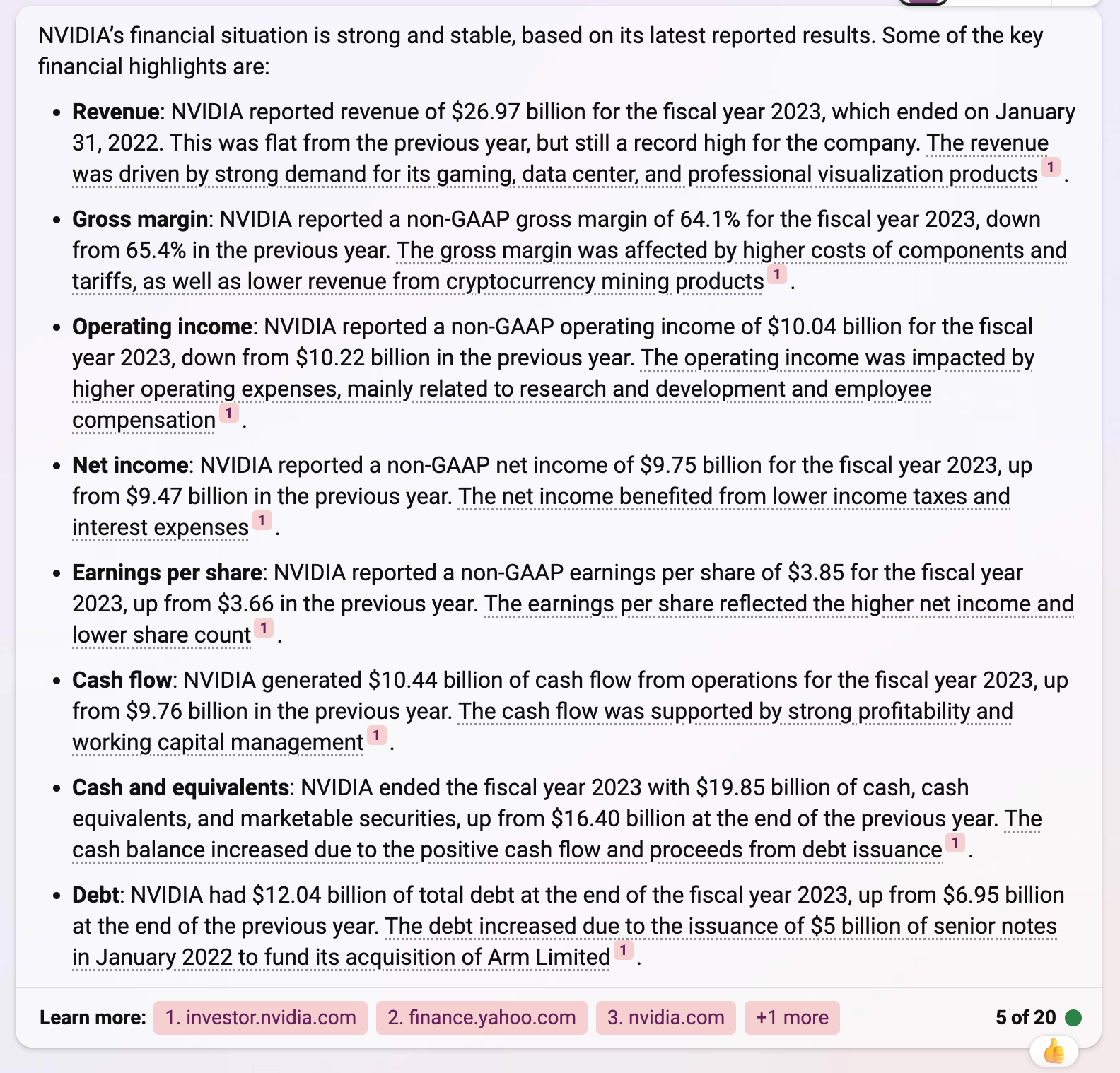
Wow! They are in a great position financially even after acquiring Arm last year. That may be something to dig into later if I have time. Or it might be worthwhile to ask questions related to it with the customer.
Because of the size of NVIDIA, target customers and markets may be a bit broad so we'll skip it for now. If we were actually meeting with NVIDIA, we'd want to pinpoint what part of the company we’d be talking with, then ask the AI about that portion!
Almost done. Let's try to understand threats and focal areas. Just as above, if this were a real conversation, we would want to focus the query around who we were meeting with but for our purposes here let's just use a broad ask of our AI business partner here:
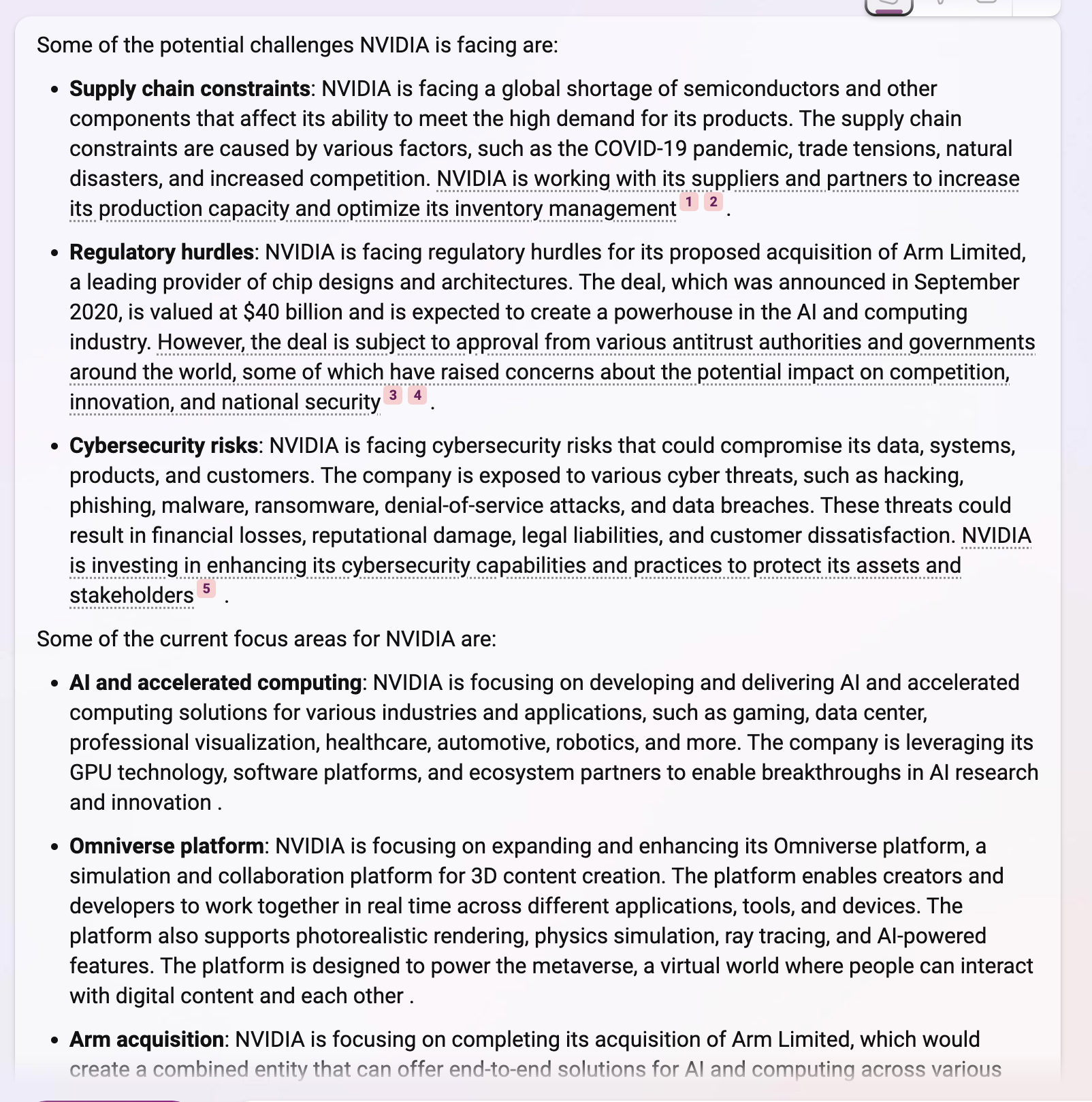
Exactly the information we needed! Now that we know about their organization, their challenges, and their focal areas, we should be able come up with several ways our company could help them.
Last area - what are they saying publicly. This is typically done by asking what their executives are saying to the press and what are their key initiatives that they are talking about publicly.


Notice the overlap with Omniverse and Grace CPU. Depending on who at NVIDIA we are talking with, these two may be worth a double click.
It is worth noting that in all these screenshots any underlined verbiage or footnote is actually a link to a source article that may be worth reading.
That’s it! In a few queries, this AI gathered enough information to build a foundational understanding of their business to the point where we met our two goals. This was waaaaayyy quicker than doing the research ourselves and the value of the information the AI brought back exceeded what would normally have been gathered in my 15 minutes.
So…it is quicker and better than doing research yourself. What’s stopping you from doing better customer research before your next intro call?
Moving forward
Now, we’ve walked through why prep is important as well as how to building a PGA (you can read that blog post here) and this post covers doing customer research. In our next conversation we will dig into the topic that I hinted at in this article - how to build a customer hypothesis.
See you next month!
PS - For those wondering if I stacked the odds in my favor by asking the AI for a public company, I repeated the same exercise asking for a VC, non-public organization. You can see those interactions here. Having never heard of Wistia, I went from ignorance to basic knowledge in a pretty short clip.
